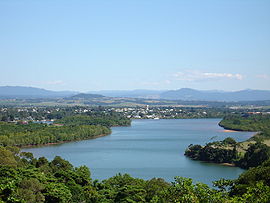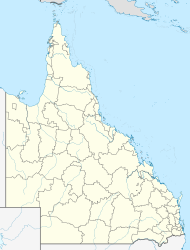Innisfail, Queensland
|
Innisfail Queensland |
|||||||||||||
|---|---|---|---|---|---|---|---|---|---|---|---|---|---|

The township of Innisfail, as seen from Coquette Point
|
|||||||||||||
| Coordinates | 17°31′25″S 146°01′45″E / 17.52361°S 146.02917°ECoordinates: 17°31′25″S 146°01′45″E / 17.52361°S 146.02917°E | ||||||||||||
| Population | 7,176 (2011 census) | ||||||||||||
| Established | 1879 | ||||||||||||
| Postcode(s) | 4860 | ||||||||||||
| Elevation | 10 m (33 ft) | ||||||||||||
| Location |
|
||||||||||||
| LGA(s) | Cassowary Coast Region | ||||||||||||
| State electorate(s) | Mulgrave | ||||||||||||
| Federal Division(s) | Kennedy | ||||||||||||
|
|||||||||||||
|
|||||||||||||
Innisfail (from Irish: Inis Fáil) a town and locality in the Cassowary Coast Region in Far North Queensland, Australia. The town was originally called Geraldton until 1910. It is the major township of the Cassowary Coast Region and is well renowned for its sugar and banana industries, as well as for being one of Australia's wettest towns. In March 2006 Innisfail gained worldwide attention when severe Tropical Cyclone Larry passed over causing extensive damage. In the 2011 census, the town of Innisfail had a population of 7,176 people.
Prior to European settlement the Innisfail area was occupied by five separate societies of the Mamu people. These Aboriginal people followed migratory lifestyles in the rainforest and traversed rivers in string-bark canoes.
The first arrival of European people came in 1872 when survivors of the shipwreck, the "Maria" arrived on the coastal areas surrounding what is now the Johnstone River. Sub-Inspector Robert Arthur Johnstone's search party came with the intention of rescuing remaining survivors. The crew would later venture up river between what is today Flying Fish Point and Coquette Point. Johnstone wrote very highly of the area, stating:
A most glorious view appeared - a noble reach of fresh water, studded with blacks with their canoes and catamarans, others on the sandy beaches; deep blue fresh water expanding to an imposing breadth.
Johnstone named the area after himself and upon his recommendation the explorer George Elphinstone Dalrymple arrived in the area in September 1873 to chart the area further.
...
Wikipedia

